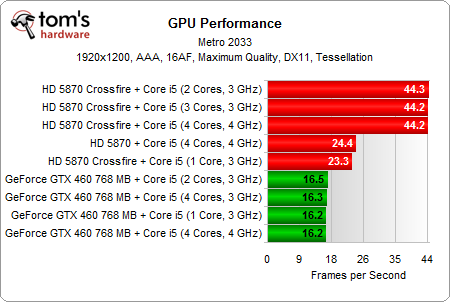The Game Rundown: Finding CPU/GPU Bottlenecks, Part 2
We're back with Part 2 of our bottleneck exploration in a mainstream gaming PC equipped with a Core i5 and GeForce GTX 460, ready to dive into test results from ten additional games. All of the results are summarized and analyzed in our conclusion.
Metro 2033
Metro 2033 stands among the generation of DirectX 11 games that showcase the graphics card as being the limiting factor. CPU utilization is at 100% with a single-core CPU, but then again, so is GPU utilization. Increasing the number of CPU cores and overclocking does not yield any higher frame rates.
To produce measureable frame rate impacts, we had to decrease the anti-aliasing to a gentler AAA mode (analytical anti-aliasing), instead of the hardware-taxing MSAA setting. Graphics memory reached its peak at 761 MB. To get better frame rates, we can only recommend a better graphics card, which is why we tested this game with the AMD Radeon HD 5870.
In extended benchmarking, we used both a single AMD Radeon HD 5870 as well as two of them in CrossFire mode. With these test results, we can elaborate a bit more on the CPU's role. The processor is still not a big factor, but it becomes relevant again with CrossFire activated. If you're going to use two graphic cards, at least pick a dual-core CPU. If you have a single-core chip, you could skip the second graphics card, as performance will be almost halved. Four processing cores and extra clock rate via overclocking is overkill, though. As long as you have a sufficiently fast dual-core CPU, then the rest will be up to the graphic cards.
Get Tom's Hardware's best news and in-depth reviews, straight to your inbox.
-
nativeson8803 It's disappointing to see that devs still aren't taking advantage of multiple cores like they could.Reply -
KingArcher Would there be any performance difference between windows 7 32bit and 64bit?Reply
Assuming you use the same amount of RAM . -
slayvus Great run down guys. I would of liked to see a three core benchmark thrown in there, but what can you expect from a dual core with HT.Reply
@KingArcher Unless the program was designed for x64, you had more than 4GB of unused RAM that the game could use and could use more than 4GB I highly doubt whether or not your on x86 or x64 would matter.
@nativeson8803 What difference would it make on games that are still GPU limited at two cores? Even then, there were games limited by the GPU at four cores. Taking advantage of a CPU with four cores or more is going to be hard when you need more GPU to get more frame rates. -
palladin9479 @Slayvus almost true. The difference would be @2 GB of available memory. NT x86 kernel only allows an application to access 2GB of address space with the other 2GB reserved for kernel use. In NT x86 world each application can only access 2GB of memory, with the application getting rather unstable once it goes over 1.8 GB. This limitation also applies to the NT x64 kernel running a 32-bit problem through WOW64. Its something left over from the NT 4.0 / 5.0 world.Reply -
archange Just keep in mind that these result are relevant in the context of using the GTX 460 768 MB, which is the real bottleneck here. Better GPUs and/or multi GPU setups would shift the bottleneck towards the CPU.Reply
In the end, it's all about finding the perfect balance in hardware. If you want my advice, pair the GTX 460 768 MB with a fast dual core, but get a good quad with higher end model GPUs. -
I'd like to see them test the first Supreme Commander.Reply
It still taxes the most powerful systems -
They should have used Phenom II X6 and test with 1/2/3/4/6 cores enabled. This made me want more of this because there aren't any 6-core benchmarks.Reply
Make a Part 3. -
lashabane archangeJust keep in mind that these result are relevant in the context of using the GTX 460 768 MB, which is the real bottleneck here. Better GPUs and/or multi GPU setups would shift the bottleneck towards the CPU.In the end, it's all about finding the perfect balance in hardware. If you want my advice, pair the GTX 460 768 MB with a fast dual core, but get a good quad with higher end model GPUs.I totally agree with archange. I understand that you're trying to go for the "norm", but if you're looking for bottlenecks, you need to remove said bottlenecks to see where it truly lays. Start with a quad core clocked at ~3.5ghz and swap out gfx from there. Push and push to see where it truly lays instead of going for a baseline. Although you can use that baseline to see what the "average" person might use. If the article is truly about the bottleneck, use something beefier than the 460.Reply



